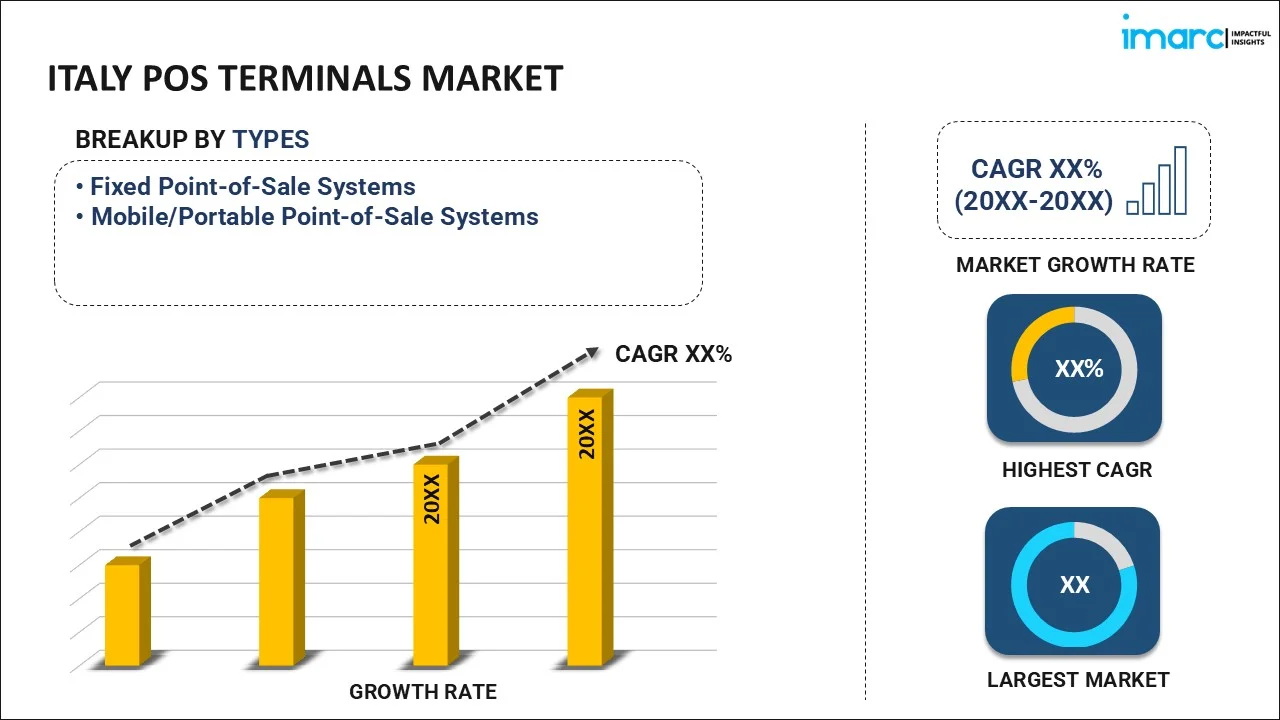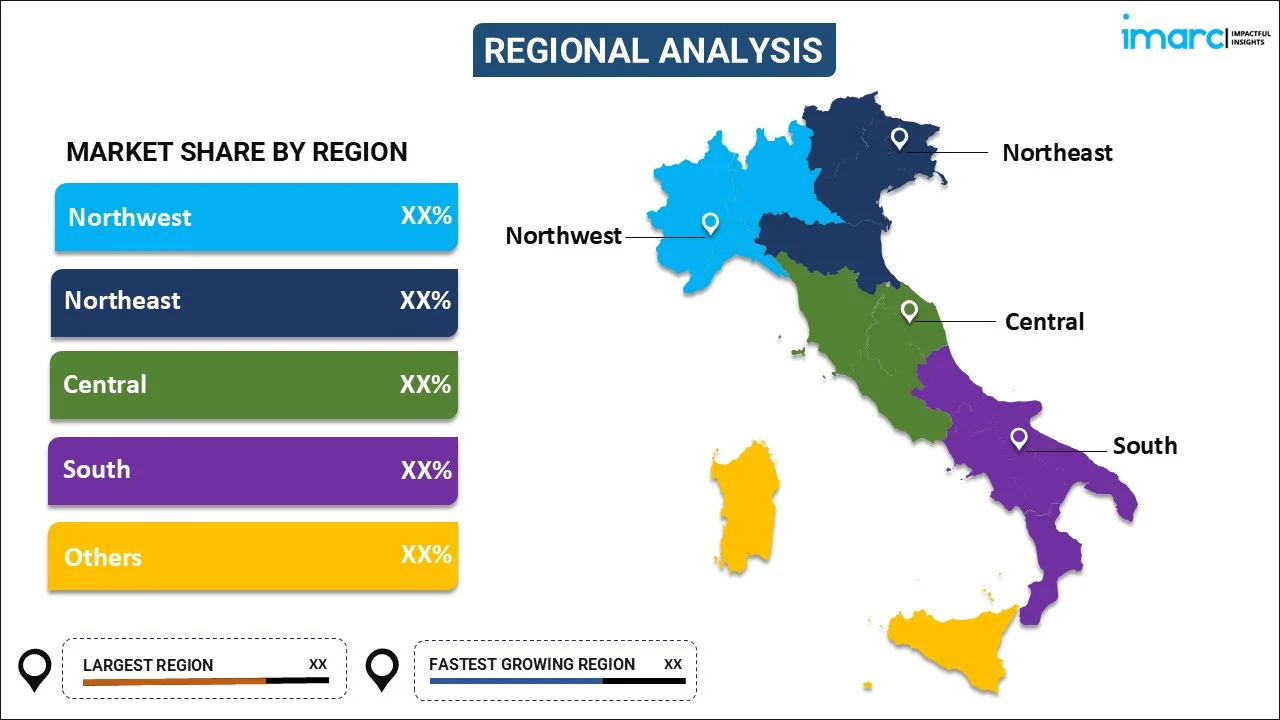
Italy POS Terminals Market Size, Share, Trends and Forecast by Type, End Use Industry, and Region, 2025-2033
Italy POS Terminals Market Overview:
The Italy POS terminals market size reached USD 2.83 Billion in 2024. Looking forward, IMARC Group expects the market to reach USD 8.52 Billion by 2033, exhibiting a growth rate (CAGR) of 12.07% during 2025-2033. The Italy POS terminals market is driven by the shift toward cashless payments, supported by government incentives and regulatory mandates, along with technological advancements such as contactless payments, mobile wallets, and cloud-based POS systems, which enhance transaction security, business efficiency, and consumer convenience, accelerating digital payment adoption across various sectors.
|
Report Attribute
|
Key Statistics
|
|---|---|
|
Base Year
|
2024 |
|
Forecast Years
|
2025-2033
|
|
Historical Years
|
2019-2024
|
| Market Size in 2024 | USD 2.83 Billion |
| Market Forecast in 2033 | USD 8.52 Billion |
| Market Growth Rate (2025-2033) | 12.07% |
Italy POS Terminals Market Trends:
Government Initiatives Promoting Digital Payments
Over the last few years, Italy has experienced a significant shift from cash transactions to electronic payments. This change is primarily driven by initiatives towards improving payment efficiency and curbing the informal economy. The Bank of Italy's consumer payment attitude report indicates that there has been a clear growth in the utilization of payment cards and other electronic means. The European Central Bank's SPACE (Study on the Payment Attitudes of Consumers in the Euro area) 2022 survey indicates that the usage of card payments in Italy has grown, mirroring a pan-European shift towards cashless transactions. This trend towards cashless payments requires the universal use of POS terminals by merchants to meet consumers' needs. Government policies have also been instrumental in this shift. Consumer and merchant incentives for using electronic payments have been introduced to push the use of traceable payment channels. These policies are meant to improve tax compliance and minimize the shadow economy, further pushing the use of POS terminals in different industries.
Technological Advancements and Infrastructure Development
The innovation in payment technologies as well as the establishment of efficient financial infrastructures have largely impacted the growth in POS terminals within Italy. Bank of Italy played a pivotal role in supervising and coordinating changes in the payment system so that infrastructures will be safe, effective, and able to offer contemporary payment innovations. The availability of contactless payment methods and mobile payment solutions has simplified electronic transactions for consumers, thus boosting demand for compatible POS terminals. Merchants are increasingly making investments in advanced POS systems to offer smooth payment experiences, cater to changing consumer needs, and remain competitive in a fast-evolving retail landscape. Furthermore, the integration of POS terminals with other business management software, like inventory and customer relationship management tools, has become value-added for merchants. It simplifies processes, increases the ability to do data analytics, and enhances the overall efficiency of the business, making the usage of sophisticated POS terminals an enticing option for firms of all scales. In addition, the mass usage of digital wallets, including Apple Pay, Google Pay, and native banking apps, has underlined the need for sophisticated POS terminals that can integrate Near Field Communication (NFC) technology. This move ties in with Italy's overall digitization push as defined in the national strategy for innovation and financial inclusion. Italian regulation and government actively promoted the development of payment infrastructure among businesses with incentives and punishments for non-observance of electronic payment directives.
Italy POS Terminals Market Segmentation:
IMARC Group provides an analysis of the key trends in each segment of the market, along with forecasts at the region/country level for 2025-2033. Our report has categorized the market based on type and end use industry.
Type Insights:

- Fixed Point-of-Sale Systems
- Mobile/Portable Point-of-Sale Systems
The report has provided a detailed breakup and analysis of the market based on the type. This includes fixed point-of-sale systems and mobile/portable point-of-sale systems.
End Use Industry Insights:
- Retail
- Hospitality
- Healthcare
- Others
A detailed breakup and analysis of the market based on the end use industry have also been provided in the report. This includes retail, hospitality, healthcare, and others.
Regional Insights:

- Northwest
- Northeast
- Central
- South
- Others
The report has also provided a comprehensive analysis of all the major regional markets, which include Northwest, Northeast, Central, South, and others.
Competitive Landscape:
The market research report has also provided a comprehensive analysis of the competitive landscape. Competitive analysis such as market structure, key player positioning, top winning strategies, competitive dashboard, and company evaluation quadrant has been covered in the report. Also, detailed profiles of all major companies have been provided.
Italy POS Terminals Market News:
- May 2024: Banca Sella extended its POS terminals to receive payments from Discover, Diners Club International, and associated cards throughout Italy. This expansion enabled merchants to accept more international customers and enhance electronic transactions. The initiative propelled the Italy POS terminals market by enhancing payment convenience and motivating businesses to upgrade their systems.
- March 2024: Worldline collaborated with the Cassa Centrale Group to operate 100,000 POS terminals in Italy, handling more than €9 billion in transactions in 2023. The partnership promotes electronic payment acceptance and increases merchant access to advanced POS systems. Reinforcing payment infrastructure drives the adoption of digital transactions in Italy.
Italy POS Terminals Market Report Coverage:
| Report Features | Details |
|---|---|
| Base Year of the Analysis | 2024 |
| Historical Period | 2019-2024 |
| Forecast Period | 2025-2033 |
| Units | Billion USD |
| Scope of the Report |
Exploration of Historical Trends and Market Outlook, Industry Catalysts and Challenges, Segment-Wise Historical and Future Market Assessment:
|
| Types Covered | Fixed Point-of-Sale Systems, Mobile/Portable Point-of-Sale Systems |
| End Use Industries Covered | Retail, Hospitality, Healthcare, Others |
| Regions Covered | Northwest, Northeast, Central, South, Others |
| Customization Scope | 10% Free Customization |
| Post-Sale Analyst Support | 10-12 Weeks |
| Delivery Format | PDF and Excel through Email (We can also provide the editable version of the report in PPT/Word format on special request) |
Key Questions Answered in This Report:
- How has the Italy POS terminals market performed so far and how will it perform in the coming years?
- What is the breakup of the Italy POS terminals market on the basis of type?
- What is the breakup of the Italy POS terminals market on the basis of end use industry?
- What are the various stages in the value chain of the Italy POS terminals market?
- What are the key driving factors and challenges in the Italy POS terminals market?
- What is the structure of the Italy POS terminals market and who are the key players?
- What is the degree of competition in the Italy POS terminals market?
Key Benefits for Stakeholders:
- IMARC’s industry report offers a comprehensive quantitative analysis of various market segments, historical and current market trends, market forecasts, and dynamics of the Italy POS terminals market from 2019-2033.
- The research report provides the latest information on the market drivers, challenges, and opportunities in the Italy POS terminals market.
- Porter's five forces analysis assist stakeholders in assessing the impact of new entrants, competitive rivalry, supplier power, buyer power, and the threat of substitution. It helps stakeholders to analyze the level of competition within the Italy POS terminals industry and its attractiveness.
- Competitive landscape allows stakeholders to understand their competitive environment and provides an insight into the current positions of key players in the market.
Need more help?
- Speak to our experienced analysts for insights on the current market scenarios.
- Include additional segments and countries to customize the report as per your requirement.
- Gain an unparalleled competitive advantage in your domain by understanding how to utilize the report and positively impacting your operations and revenue.
- For further assistance, please connect with our analysts.
 Request Customization
Request Customization
 Speak to an Analyst
Speak to an Analyst
 Request Brochure
Request Brochure
 Inquire Before Buying
Inquire Before Buying




.webp)




.webp)












